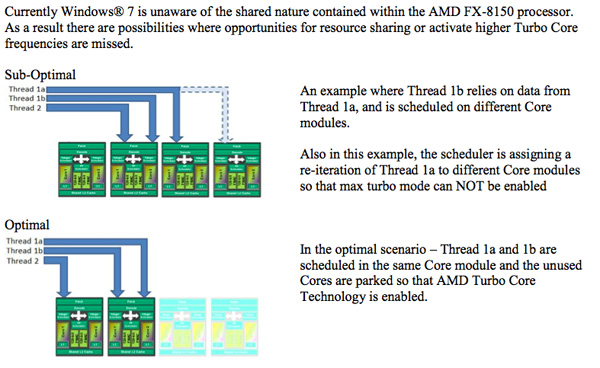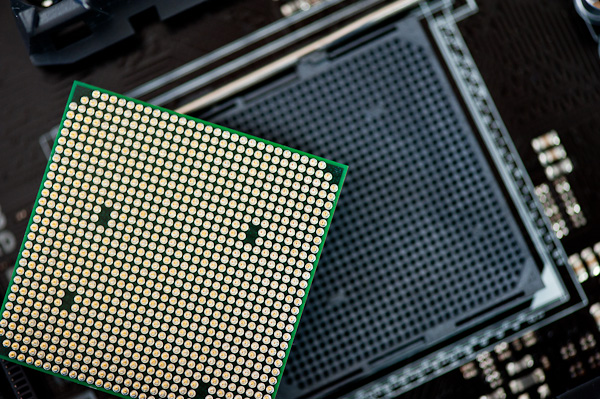The Bulldozer Review: AMD FX-8150 Tested
by Anand Lal Shimpi on October 12, 2011 1:27 AM ESTFinal Words
In many cases, AMD's FX-8150 is able to close the gap between the Phenom II X6 and Intel's Core i5 2500K. Given the right workload, Bulldozer is actually able to hang with Intel's fastest Sandy Bridge parts. We finally have a high-end AMD CPU with power gating as well as a very functional Turbo Core mode. Unfortunately the same complaints we've had about AMD's processors over the past few years still apply here today: in lightly threaded scenarios, Bulldozer simply does not perform. To make matters worse, in some heavily threaded applications the improvement over the previous generation Phenom II X6 simply isn't enough to justify an upgrade for existing AM3+ platform owners. AMD has released a part that is generally more competitive than its predecessor, but not consistently so. AMD also makes you choose between good single or good multithreaded performance, a tradeoff that we honestly shouldn't have to make in the era of power gating and turbo cores.
Bulldozer is an interesting architecture for sure, but I'm not sure it's quite ready for prime time. AMD clearly needed higher clocks to really make Bulldozer shine and for whatever reason it was unable to attain that. With Piledriver due out next year, boasting at least 10-15% performance gains at the core level it seems to me that AMD plans to aggressively address the shortcomings of this architecture. My only concern is whether or not a 15% improvement at the core level will be enough to close some of the gaps we've seen here today. Single threaded performance is my biggest concern, and compared to Sandy Bridge there's a good 40-50% advantage the i5 2500K enjoys over the FX-8150. My hope is that future derivatives of the FX processor (perhaps based on Piledriver) will boast much more aggressive Turbo Core frequencies, which would do wonders at eating into that advantage.

AMD also shared with us that Windows 7 isn't really all that optimized for Bulldozer. Given AMD's unique multi-core module architecture, the OS scheduler needs to know when to place threads on a single module (with shared caches) vs. on separate modules with dedicated caches. Windows 7's scheduler isn't aware of Bulldozer's architecture and as a result sort of places threads wherever it sees fit, regardless of optimal placement. Windows 8 is expected to correct this, however given the short lead time on Bulldozer reviews we weren't able to do much experimenting with Windows 8 performance on the platform. There's also the fact that Windows 8 isn't expected out until the end of next year, at which point we'll likely see an upgraded successor to Bulldozer.

So what do you do if you're buying today? If you have an existing high-end Phenom II system, particularly an X4 970 or above or an X6 of any sort, I honestly don't see much of a reason to upgrade. You're likely better off waiting for the next (and final) iteration of the AM3+ lineup if you want to stick with your current platform. If you're considering buying new, I feel like the 2500K is a better overall part. You get more predictable performance across the board regardless of application type or workload mix, and you do get features like Quick Sync. In many ways, where Bulldozer is a clear win is where AMD has always done well: heavily threaded applications. If you're predominantly running well threaded workloads, Bulldozer will typically give you performance somewhere around or above Intel's 2500K.
I was hoping for Bulldozer to address AMD's weakness rather than continue to just focus on its strengths. I suspect this architecture will do quite well in the server space, but for client computing we may have to wait a bit longer for a more competitive part from AMD. The true culprit for Bulldozer's lackluster single-threaded performance is difficult to track down. The easy answer would seem to be clock speed. We've heard of issues at Global Foundries and perhaps Bulldozer is the latest victim. If AMD's clock targets were 30% higher than Phenom II, it simply didn't make them with the FX-8150. I've heard future derivatives will focus more on increasing IPC indepedent of process technology and clock speed, but if you asked me what was the one limit to success I would say clock speed. As a secondary factor, AMD appeared to make some tradeoffs to maintain a reasonable die size at 32nm. Even then Bulldozer can hardly be considered svelte. I suspect as AMD is able to transition to smaller transistor geometries, it will be able to address some of Bulldozer's physical shortcomings.
The good news is AMD has a very aggressive roadmap ahead of itself; here's hoping it will be able to execute against it. We all need AMD to succeed. We've seen what happens without a strong AMD as a competitor. We get processors that are artificially limited and severe restrictions on overclocking, particularly at the value end of the segment. We're denied choice simply because there's no other alternative. I don't believe Bulldozer is a strong enough alternative to force Intel back into an ultra competitive mode, but we absolutely need it to be that. I have faith that AMD can pull it off, but there's still a lot of progress that needs to be made. AMD can't simply rely on its GPU architecture superiority to sell APUs; it needs to ramp on the x86 side as well—more specifically, AMD needs better single threaded performance. Bulldozer didn't deliver that, and I'm worried that Piledriver alone won't be enough. But if AMD can stick to a yearly cadence and execute well with each iteration, there's hope. It's no longer a question of whether AMD will return to the days of the Athlon 64, it simply must. Otherwise you can kiss choice goodbye.











430 Comments
View All Comments
Kristian Vättö - Wednesday, October 12, 2011 - link
I'm happy that I went with i5-2500K. Performance, especially in gaming, seems to be pretty horrible.ckryan - Wednesday, October 12, 2011 - link
I was just going to say the same thing. I was all about AMD last year, but early this year I picked up an i5 2500K and was blown away by efficiency and performance even in a hobbled H67. Once I bought a proper P67, it was on. It's not that Bulldozer is terrible (because it isn't); Sandy Bridge is just a "phenom". If SB had just been a little faster than Lynnfield, it would still be fast. But it's a big leap to SB, and it's certainly the best value. AMD has Bulldozer, an inconsistent performer that is better in some areas and worse in others, but has a hard time competing with it's own forebearer. It's still an unusual product that some people will really benefit from and some wont. The demise of the Phenom II can't come soon enough for AMD as some people will look at the benchmarks and conclude that a super cheap X4 955BE is a much better value than BD. I hope it isn't seen that way, but it's not a difficult conclusion to reach. Perhaps BD is more forward looking, and the other octocore will be cheaper than the 8150 so it's a better value. I'd really like to see the performance of the 4- and 6- before making judgement.It's still technically a win, but it's a Pyrrhic victory.
ogreslayer - Wednesday, October 12, 2011 - link
I tell friends that exact thing all the time. Phenoms are great CPUs but switch to Nehelam or Sandy Bridge and the speed is noticibly different. At equal clocks Core 2 Quads are as fast or faster.Bulldozer ends up with a lot of issues fanboys refused to see even though Anandtech and other sites did bring it up in previews. I guess it was just hope and a understandable disbelief that AMD would be behind for a decade till the next architecture. We can start at clockspeed but only being dual-channel is not helping memory bandwidth. I don't think there is enough L3 and they most definitely should have a shortpipeline to crush through processes. They need an 1.4 to 1.6 in CBmarks or what is thhe point of the modules.
The module philosophy is probably close to the future of x86 but I imagine seeing Intel keeping HT enabled on the high-end SKUs. Also I think both of them want to switch FP calculation over to GPUs.
slickr - Wednesday, October 12, 2011 - link
Yeah I agree. To me Bulldozer comes like 1 year late.Its just not competitive enough and the fact that you have to make a sacrifice to single threaded performance for multithreaded when even the multithreaded isn't that good and looses to 2600K is just sad.
They needed to win big with Bulldozer and they failed hard!
retrospooty - Wednesday, October 12, 2011 - link
Ya, it seems to be a pattern lately with the last few AMD architectures.1. Hype up the CPU as the next big thing
2. Release is delayed
3. Once released, benchmarks are severely underwhelming
JasperJanssen - Wednesday, October 12, 2011 - link
4. Immediately start hyping up the next release as the salvation of all.GatorLord - Thursday, October 20, 2011 - link
It looks to me like BD is the CPU beta bug sponge for Trinity and beyond. Everybody these days releases a beta before the money launch.Hence the B3 stepping...and probably a few more now that a capable fab is onboard with TSMC. BD is not a CPU like we're used to...its an APU/HPC engine designed to drive code and a Cayman class GPU at 28nm and lots of GHz...I get it now.
Also, the whole massive cache and 2B transistors, 800M dedicated to I/O, thing (SB uses 995M total) finally makes sense when you realize that this chip was designed to pump many smaller GPGPU caches full of raw data to process and combine all the outputs quickly.
Apparently GPUs compute very fast, but have slow fetch latencies and the best way to overcome that is by having their caches continously and rapidly filled...like from the CPU with the big cache and I/O machine on the same chip...how smart..and convenient...and fast.
Can you say 'OpenCL'?
jleach1 - Friday, October 21, 2011 - link
I don't see how this can be considered an APU, This product isn't being marketed as a HPC proc., and i don't see the benefit of this architecture design in GPGPU environments at all.It's sad...i've always given major kudos to AMD. Back in the days of the Athlon's prime, it was awesome to see david stomping goliath.
But AMD has dropped the ball continuously since then. Thuban was nice, but it might as well be considered a fluke, seeing as AMD took a worthy architecture (Thuban) and ditched it for what's widely considered as a joke.
And the phrase "AMD dropped the ball" is an understatement.
They've ultimately failed. They havent competed with Intel in years. They...have...failed. After thuban came out i was starting to think that the fact that they competed for years on price and clock speed alone was a fluke, and just a blip on the radar. Now i see it the opposite way...it seems that AMD merely puts out good processors every once in a while...and only on accident.
medi01 - Wednesday, October 12, 2011 - link
Well, if anand didn't badmouth AMD's GPU's on top of CPU's, we would see less "fanboys" complainging about anand's bias.vol7ron - Wednesday, October 12, 2011 - link
By badmouth do you mean objectively tell the truth? Do you blame PCMark or FutureMark for any of that? Perhaps if all the tests just said that AMD was clearly better, it wouldn't be badmouthing anymore.